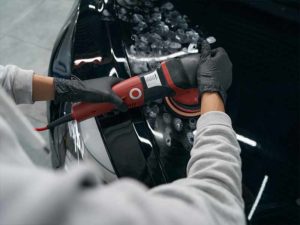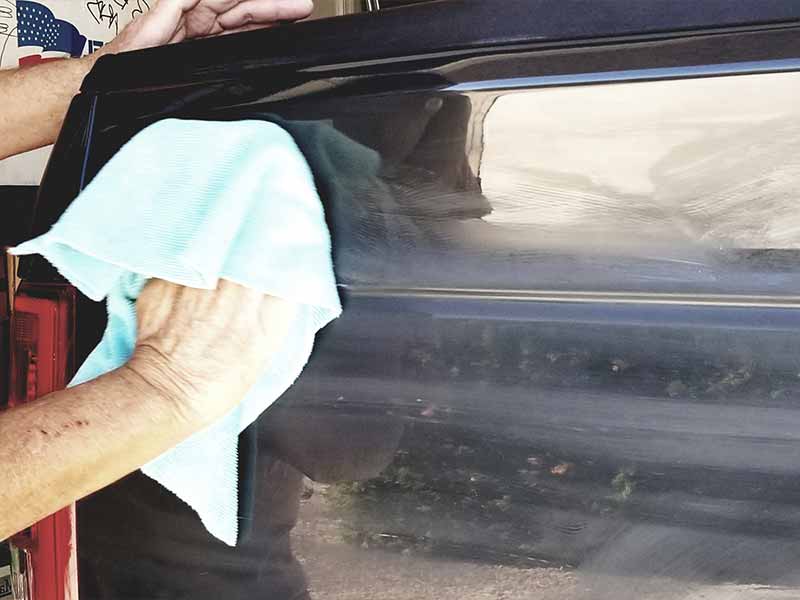Table of Contents
There are several types of car scratches, but they really fall into one of two different categories: a clear coat scratch or anything deeper.
In this article we’ll cover how to determine if you’re dealing with a clear coat scratch or a deep scratch. What it means when you have one of these car scratches. How to fix each of these types of scratches. And how to help prevent them from happening in the first place.
Clear Coat Scratch Vs Deep Scratch
Clear coat scratches are light scratches that are only in the surface of the clear coat layer. Deep scratches are those that penetrate through the clear coat layer and at least into the base coat layer.
Deep scratches can go even deeper and penetrate through the primer coat layer all the way through to the bare metal.
Clear coat scratches are relatively easy to remove. Deep scratches are much more difficult to fix. Fixing scratches that have penetrated through the clear coat will require touch up paint or repainting of the entire area surrounding the scratch to blend in the new paint with the paint.
How To Tell If A Car Scratch Is Deep
Car scratches happen. Your first question is likely going to be, how difficult (or expensive) is this going to be to fix.
An easy way to tell how deep a car paint scratch is, is to use the fingernail test. The fingernail test works by simply dragging your fingernail lightly across the scratch. If your fingernail catches in the scratch, it’s a deep scratch.

Clear Coat Scratches On Car Paint
Clear coat scratches are fine scratches that are only in the surface of the clear coat. These light clear coat scratches can be easily polished out and leave the paint job looking as good as new, literally!
Clear coat is designed to be a sacrificial layer on top of your car’s paint. This thin layer has enough thickness to be polished to remove surface scratches such as swirl marks and other lighter scratches.
Clear Coat Scratch Repair
Removing clear coat scratches involves using polishing compound and a dual action polisher to wear away a very thin layer from the top of the clear coat to reveal unscratched clear coat beneath.
This may sound intimidating to the unfamiliar, but it’s actually a fairly DIY-friendly process.
How To Remove Scratches From Clear Coat Step-By-Step
- Start by thoroughly washing your vehicle’s paint to remove as much dirt and road grime as possible. Check out the our article on the 2 bucket method to learn how to safely wash your car or truck without causing more clear coat scratches.
- If your vehicle’s paint feels rough, you may want to consider using a clay bar to remove these contaminants from your car’s paintwork before you begin. If your paint is heavily contaminated, these contaminants can get caught in the polishing pad and create more problems.
- Apply some mild polish to your polishing pad and dab around the area you are going to be working on. Try to limit the area you’ll be polishing to no more than a 2 foot square if you’re using a dual action polisher. If you’re hand polishing, you’ll want to focus on a much smaller section.
- Use a circular motion if you’re polishing by hand. If you’re using a dual action polisher, move back and forth across the panel horizontally. Overlap your passes to ensure you don’t miss any areas. Repeat with the DA polisher vertically up and down across the same section, still overlapping by a third to ensure good coverage.
- If you’re having trouble making good progress you may want to consider stepping up to a more abrasive polish or a compound. If you do step up to something more aggressive, you’ll have to follow it with the mild polish to restore the shine.
- Once you’re satisfied with one section, move on to the next section and repeat until the entire surface that needs light scratch repair is complete.

Deep Scratches On Car Paint
A deep scratch is any scratch that has gone all the way through the clear coat and into the base coat, the primer coat, or exposed bare metal.
Deep car scratches are more problematic than light scratches. You can’t polish out deep car scratches. Paint scratches that have penetrated through the clear coat will need touch up paint at a minimum.
You can’t polish clear coat completely away without the paint underneath being exposed looking discolored without the glossy finish of the clear coat. It will look worse than the scratch alone.
Also, losing the protection of the clear coat will cause the paint layer beneath to begin breaking down quickly.
Deep Scratch Repair
As mentioned earlier, touch up paint will be required to adequately repair a deep scratch. The main reason is that you will need to replace the missing paint.
You’ll also need to replace the missing clear coat so that the color matches as close as possible to the original paint.
How To Remove A Deep Scratch From Car Paint
- Wet sand the edges of the scratch so the entire scratch smoothly transitions to the unscratched area
- Clean the sanded scratch with rubbing alcohol to prep the surface for touch up paint
- Add touch-up paint in layers, allowing drying time between applications until the layers are higher than the factory paint
- Wet sand the touch-up paint down until even with the factory paint
- Apply 2 layers of clear coat overlapping onto the factory paint
- Wet sand clear clear coat down until even with the factory paint
- Wipe with rubbing alcohol again
- Use polish on the entire area with a dual action polisher
How To Protect Car Paint From Scratches
Aside from ensuring you wash your car or truck safely, park away from other vehicles, and keep your car or truck in a garage, there are 2 main paint protection products that can actually help prevent scratches:
Ceramic Coating
Ceramic coatings are hard coatings that can be applied to your clear coat and actually help prevent minor scratches and even potentially tiny rock chips.
The amount of scratch protection that a ceramic coating can provide is needs to be kept in perspective though. A ceramic coating can prevent clear coat scratches and other minor scratches and stone chips that wouldn’t likely penetrate through the clear coat. But it isn’t going to prevent deep car scratches, door dings, or other more significant paint scratches.
Ceramic coatings are really impressive at their ability to protect your paint but they aren’t exactly magic. If you’re interested in learning more, be sure and check out our article on the advantages and disadvantages of ceramic coatings.
Paint Protection Film (PPF)
Paint protection films are much better at their ability to prevent car scratches. PPF can easily prevent a clear coat scratch and other lighter scratches. It can absorb these scratches and not suffer any permanent damage to the film itself.
Moderate scratches can also be repelled from your car’s paint just as well. Even some things that would cause a deeper scratch could be prevented by paint protection film, although the film itself may be damaged and need replacing on that panel.
Paint protection film is an extremely impressive product that has its own pros and cons. If you want to learn more, be sure and read our article about whether PPF is worth the expense.
Paint Layers
A car’s paint is made up of several layers. Let’s go over what each one these layers are what purpose they serve.
Clear Coat
On most modern cars, the top most layer, and thickest layer, is the clear coat. The clear coat is a sacrificial layer that is purposely thick to allow it to be polished to remove clear coat scratches that don’t penetrate through to any other paint layers.
The clear coat also includes UV inhibitors that help protect the car’s paint layer from fading due to ultraviolet rays from the sun. The UV inhibitors in the clear coat will also help keep the clear coat itself from breaking down and becoming hazy and eventually peeling away due to the sun’s UV rays.
Finally, clear coat also creates the depth of gloss and shine that helps paint look great.
Base Coat
The base coat, which is sometimes referred to as the color coat is the main paint color layer directly beneath the clear coat.
The base coat will need to be touched up if you have base coat scratches. The touch up paint used will need to match the factory paint color and include a clear coat to be applied over it to restore the car scratch back to the same look as the original paint job.
Primer Coat
The primer coat is a thin layer that is applied directly to the bare metal surface to help the base coat adhere to the body panel.
A car paint scratch that has penetrated this deep can be touched up in the same way as base coat scratches. You don’t need to reapply primer to a thin scratch for the paint to properly adhere.
The only time a primer may need to be reapplied is on larger areas with exposed bare metal. At that point you’ll be looking at repainting instead of touching up.
Bare Metal
Any paint scratch that has penetrated through all of the paint layers and exposed bare metal beneath should be touched up as soon as possible to help prevent rust.
Rust can begin breaking down the paint from underneath and cause some serious damage to your paint job.

Helpful Links
Conclusion
Car scratches are an unfortunate reality. Unless you have a garage queen, you’re going to eventually get some sort of scratch, whether it’s a clear coat scratch or something worse.
Any paint scratch is a hassle, but they can all be fixed. It’s just a matter of a little elbow grease and know-how.
Hopefully we’ve armed you with enough of the later to make a good beginning on removing your car scratches and preventing future ones.
Good luck and happy detailing.









